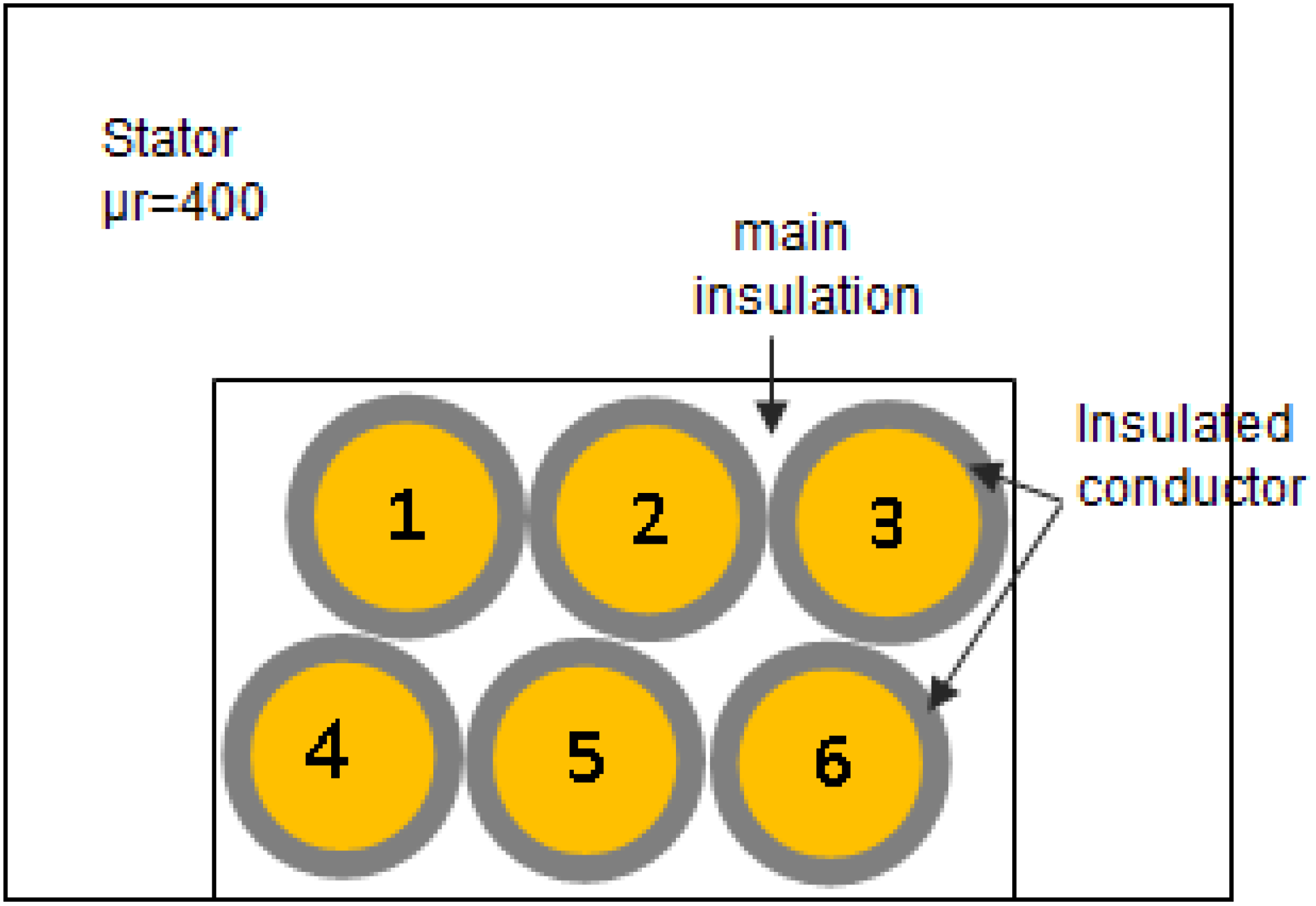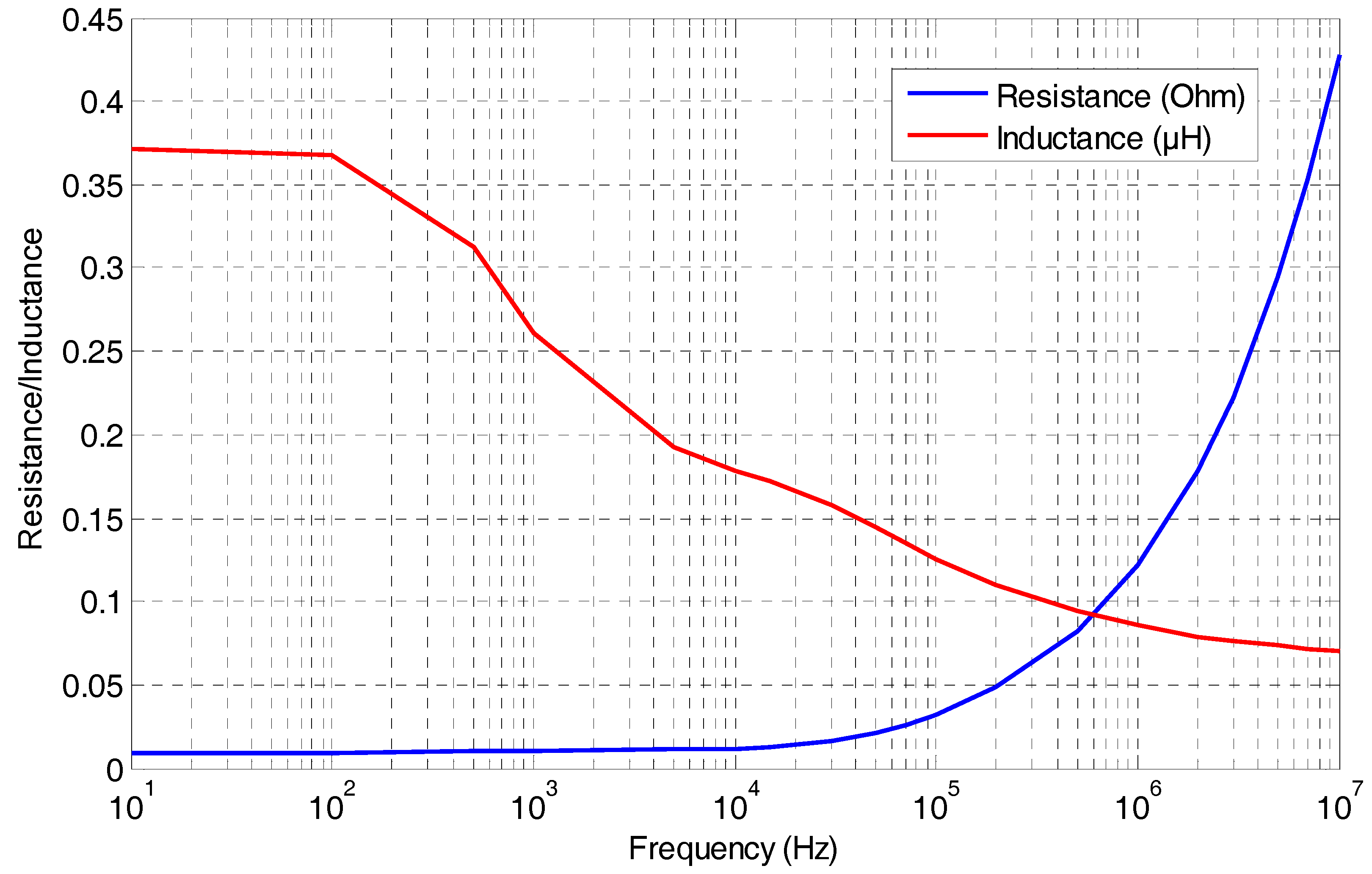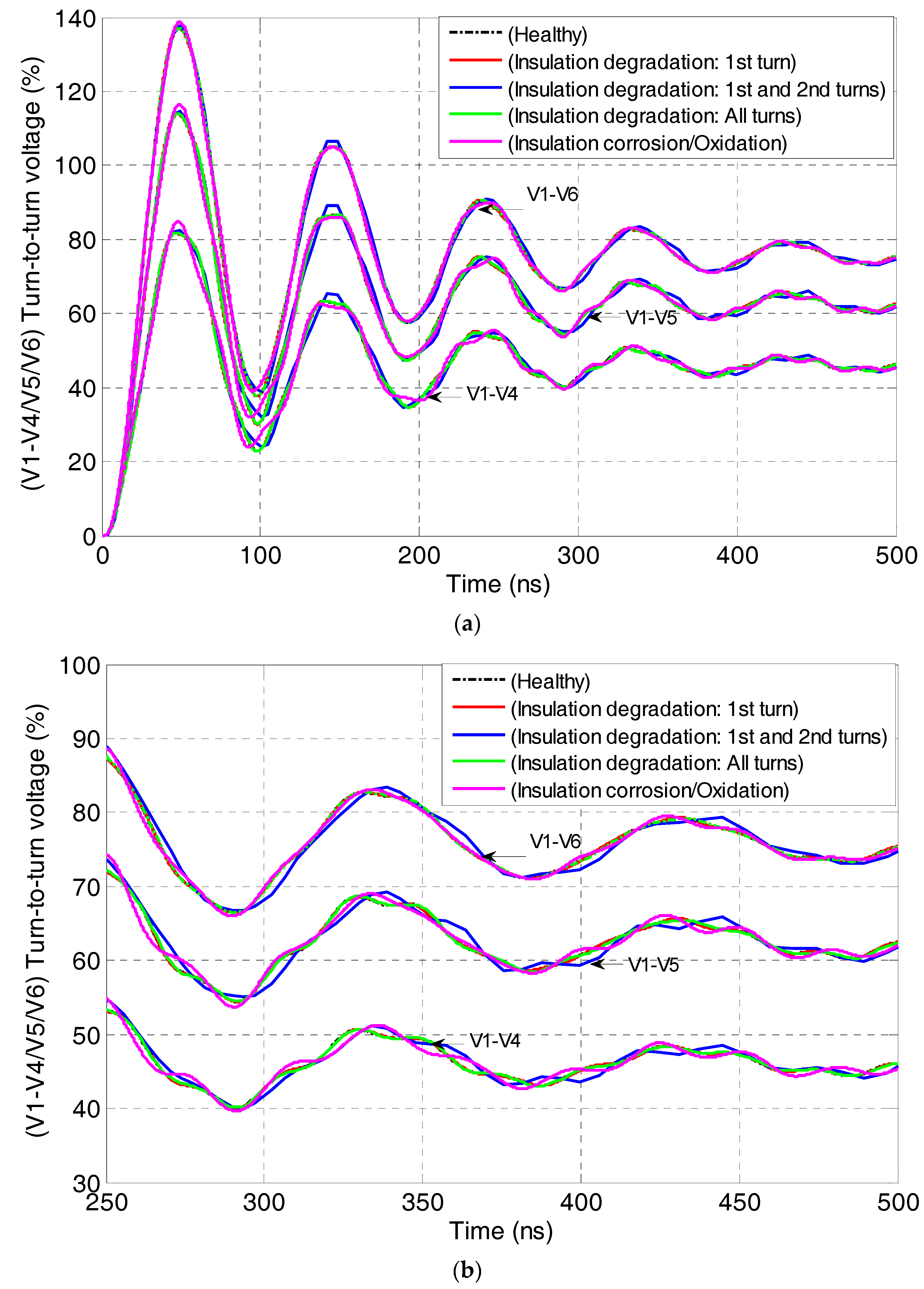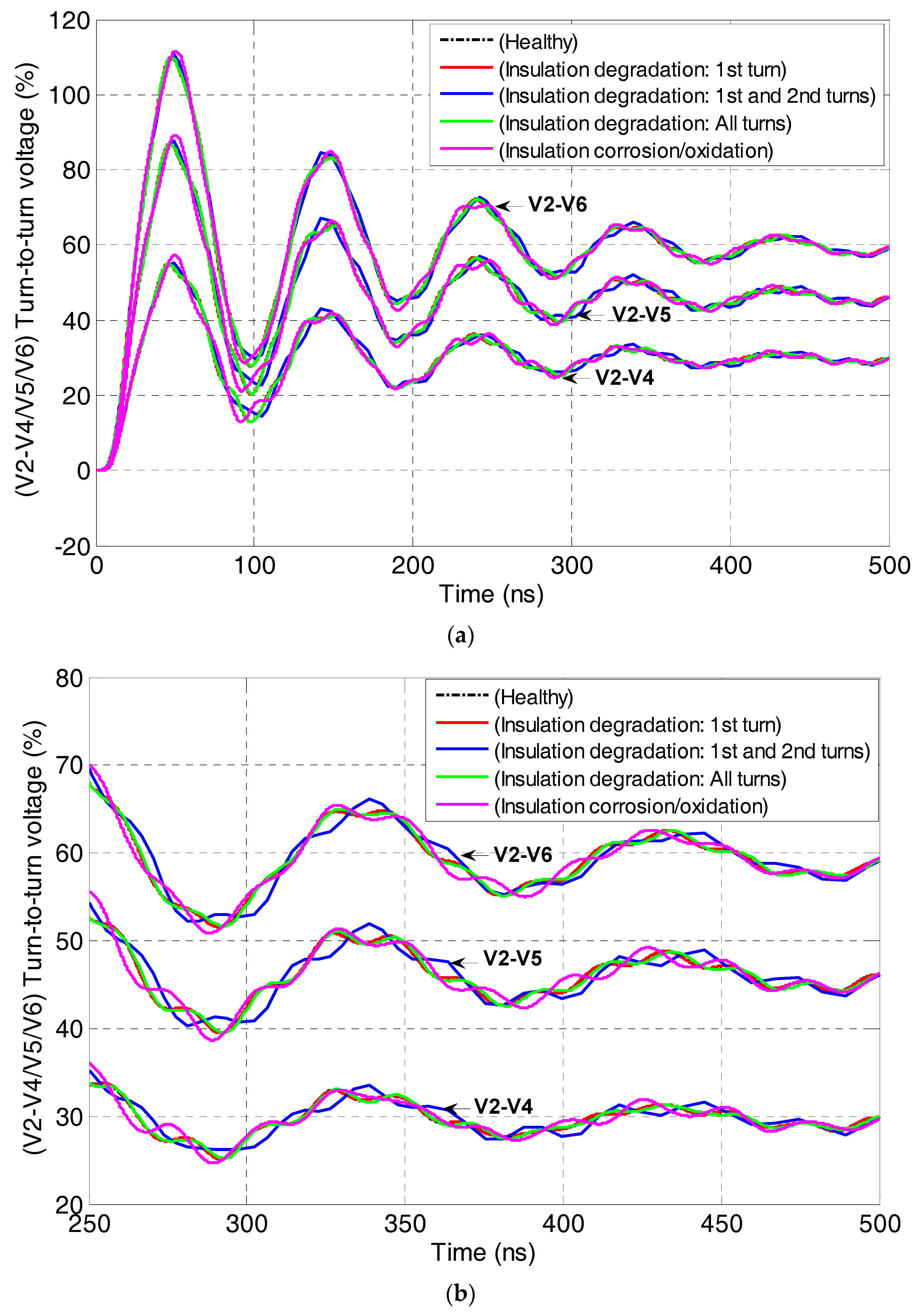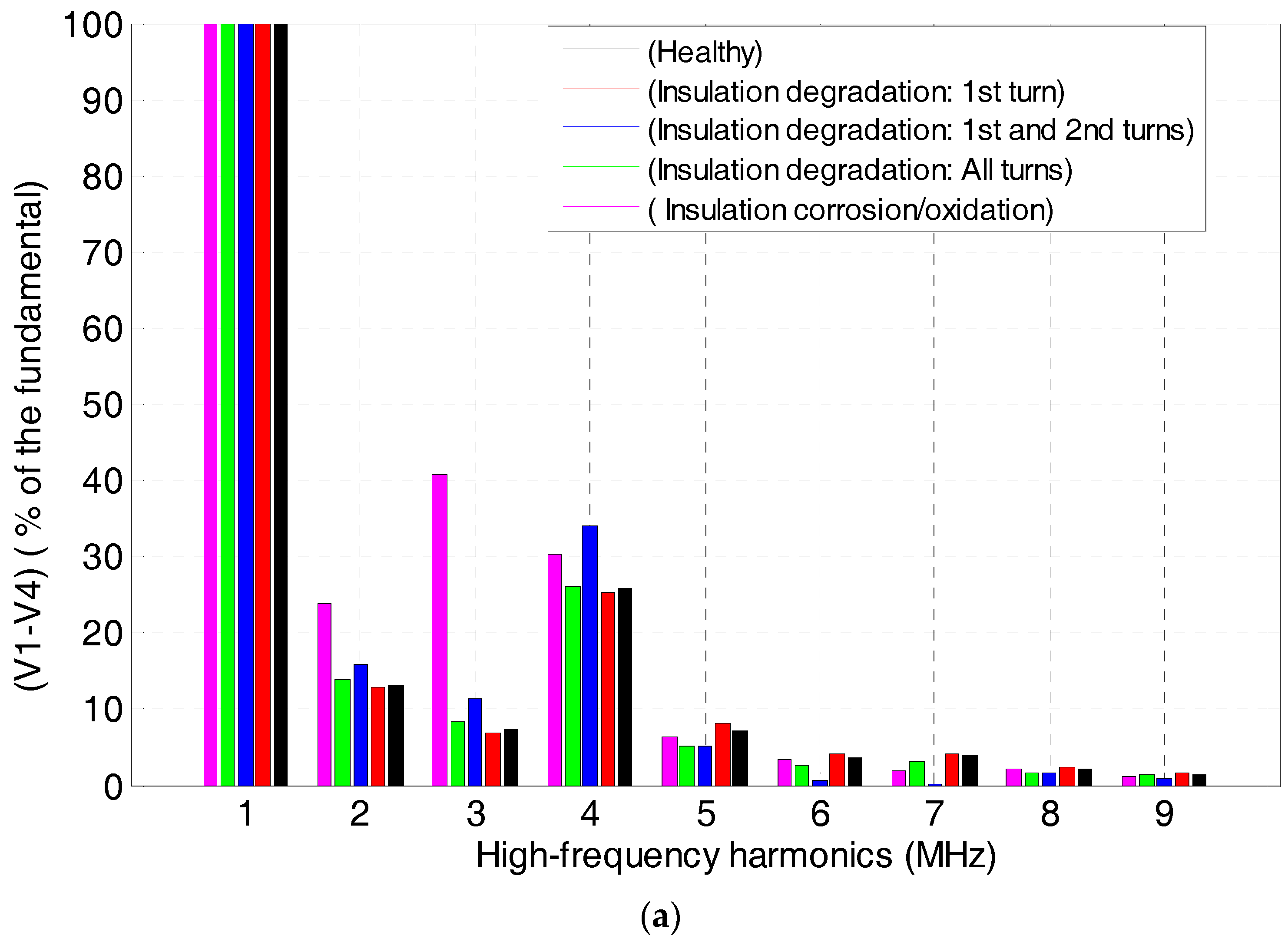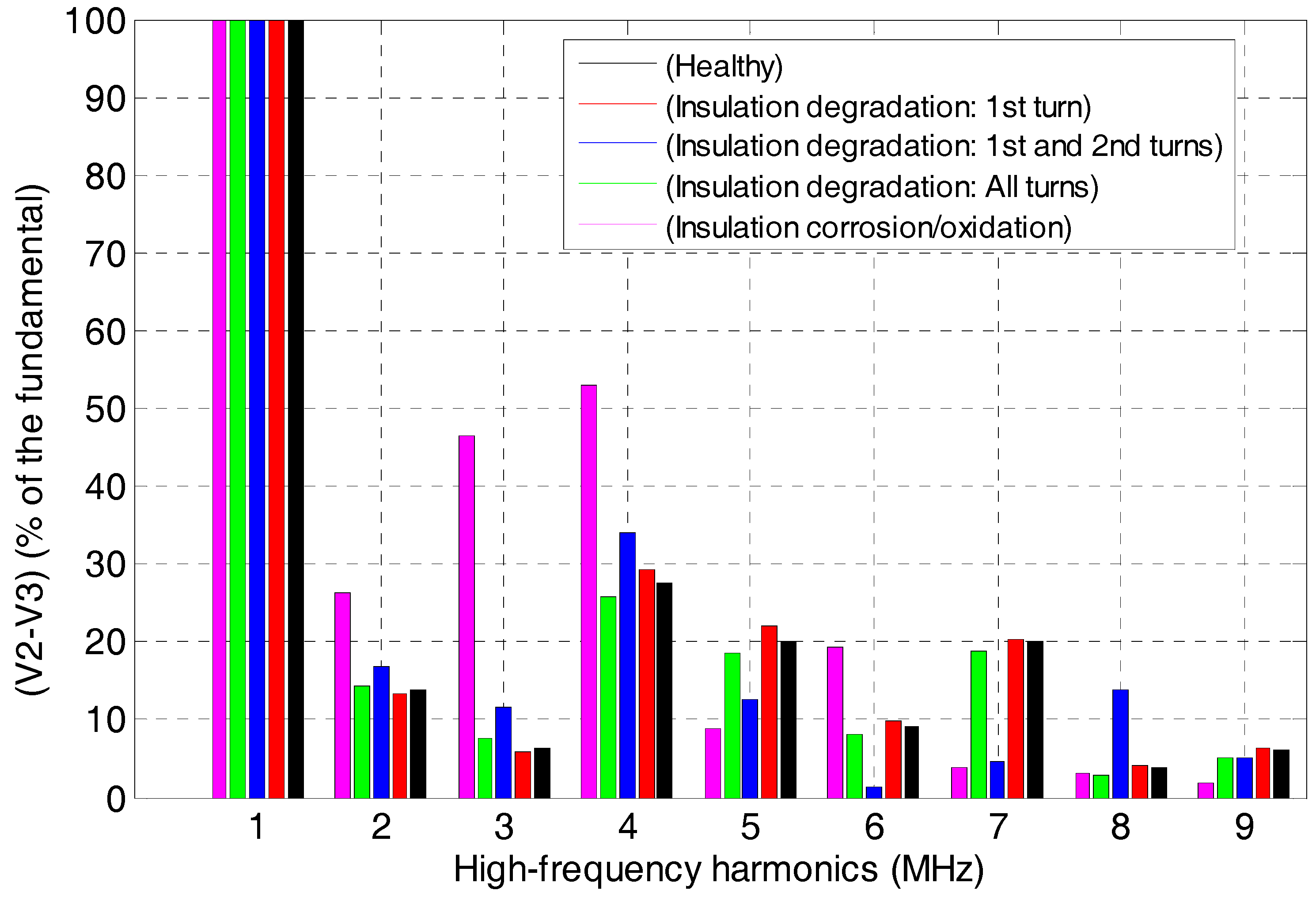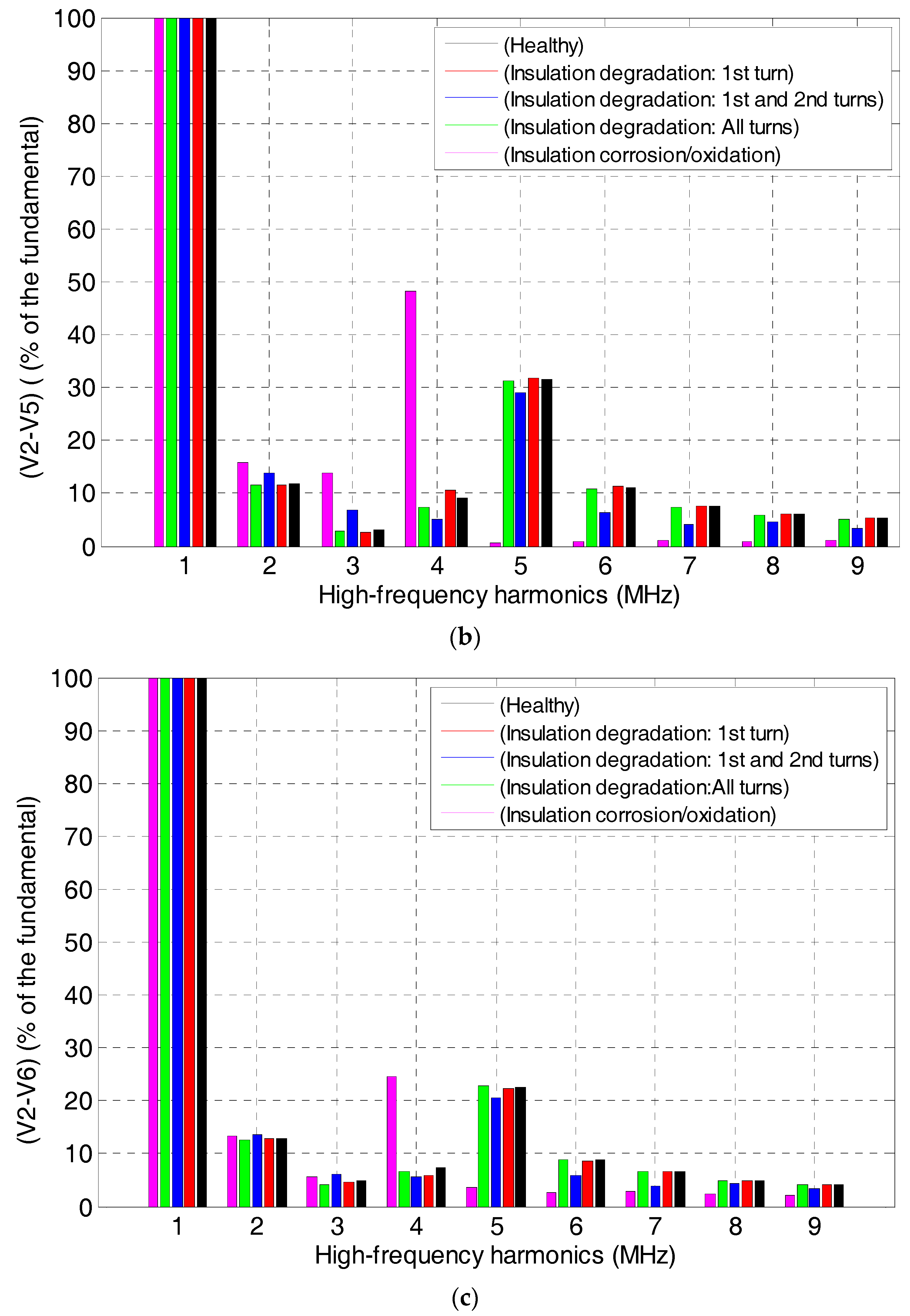1. Introduction
The Electrical Insulation System (EIS) materials are the heart of electrical equipment. During operation, EIS materials may be subject to different aging mechanisms or insulation failure resulting from stresses induced by a variety of factors, including thermal (additional heating, thermal overload), electrical (high-energy transient voltages, partial discharges), ambient stress (contamination, accumulated moisture, high humidity, aggressive chemicals), mechanical (moving/vibrations of coils), and voltage spikes, caused by the voltage source of the converters [
1,
2,
3].
The high frequency switching of semiconductor devices results in repetitive and uneven voltage transients, an increased high frequency harmonic content, highly-distorted waveform magnitudes, and over voltages because of resonance. Each of these factors play an important role in degradation of insulation reliability and cause localized supplementary electrical and thermal stresses on EIS, and increased dielectric and Joule losses as well as an increased operating temperature. Moreover, increased electric stress is the main cause of accelerated degradation of insulation dielectric properties, which drastically impacts the lifetime of insulation [
4,
5,
6,
7].
Insulation testing and monitoring methods can generally be divided into two different categories. The first one is offline testing, which requires the electrical equipment to be removed from service, whereas the second one is online monitoring, which can be performed during operation. The popular, reliable, and very frequently used online methods to assess the turn-to-turn insulation system of medium and high voltage electrical equipment are the Voltage Surge test and the Partial Discharge (PD) test, which also can be applied offline [
8,
9]. Common offline test methods used to test the phase-to-ground insulation are the Insulation Resistance (IR), the Polarization Index (PI), and the Dissipation Factor (DF). Other new techniques, such as the Recovery Voltage Method (RVM), the Dielectric Frequency Response (DFR) measurements, the Fourier Transform Infrared (FTI), and Power Factor (PF) as a function of frequency, etc., are still being explored. Online monitoring refers to “tests” that are done during operation of the motor or generator. Therefore, no outage is needed, although, for some monitors, the operating condition of the machine is changed to extract the greatest amount of diagnostic information [
10,
11,
12,
13].
Various monitoring methods have been developed using different physical quantities to detect the health condition of a stator insulation system. These methods utilize different motor parameters, like magnetic flux, temperature, stator current, or input power for monitoring purposes. Online condition monitoring is usually preferred in applications that have a continuous process, such as petro/chemical, water treatment, material handling, etc. The major advantage of this method is that the machine does not have to be taken out of service. As a result, the health condition while the motor is operating can be assessed. Predictive maintenance is made easier because the machine is under constant monitoring, an incipient failure can immediately be detected, and actions can be scheduled to avoid more severe downtime. A disadvantage is that the online monitoring techniques often require the installation of additional equipment, which has to be installed on every machine. Compared to the offline tests, it is more difficult or even impossible to detect some failure processes. However, many sensorless and non-intrusive methods have been recently developed using electrical signatures, e.g., current and voltage, such that the monitoring algorithm can reside in the motor control center or even inside of motor control devices, such as the drives. Therefore, the online monitoring can be non-intrusive without the need for additional sensors and installations [
14,
15].
Capacitance is considered a critical factor which can define the lifetime of the EIS. So, the premature supervision of insulation ageing or degradation requires the evolution of capacitance to be followed during operation, specifically its dielectric and geometrical characteristics. Ambient stresses, such as humidity, affect the insulation material in two different ways: first, by penetrating inside the bulk of the insulation and second, by corrosion or copper oxidation processes which form a conductive layer of moisture on the insulation internal surface. To achieve these goals, Non-Destructive Testing (NDT) condition assessment is necessary to evaluate and diagnose the EIS quality.
The paper focuses on the investigation of Winding-(EIS) Diagnosis Indicators (DI) through the correlations between the capacitance changes and the resulting Transient Voltage Signature Analysis (VSA) along the turns obtained from the model-based High Frequency Transmission Line Lumped Electromagnetic RLMC-Circuits. These transient voltages initiated by the fast switching in voltage source converters are mainly influenced by the parasitic capacitive components of the drive. Insulation degradation is always linked with a change of capacitance that is considered one of the DI parameters for insulation health state evaluation.
The first part of the paper aims to establish an accurate Finite Element (FE) Electromagnetic (EM) model to compute distributed RLMC-circuits parameters, like resistance (R), self/mutual inductance (L/M) and capacitance (C) between turn-to-ground and between turn-to-turn according to their frequency dependency. Significant improvements are achieved through the correlation between the predominant skin and inductive/capacitive proximity effects and the frequency dependent (R,L,M,C) parameters. Using the Supply Electric Total Current (SETC) process, the frequency-dependent (R,L,M) parameter matrices of the insulated-winding are derived from Finite Element (FE) formulation of the strongly coupled (A-I) model formed by the magnetic field diffusion equation expressed in terms of magnetic vector potential (A), and the total current (I) equation expressed in terms of source, conductive eddy current and displacement eddy current densities. The capacitance matrix, derived from the electrostatic energy, is calculated after sequentially solving the FE formulation of the electrostatic Laplace equation, expressed in terms of electric scalar potential (V). The Floating Electrostatic Potential (FEP) process is used to assign appropriate voltages to the conductor boundaries.
The state of health of the insulation can be assessed by identifying and tracking changes in capacitance; consequently, the second part of this paper describes the insulated-winding high-frequency RLMC-circuit model developed in order to investigate the impact of the turn-to-ground and the turn-to-turn capacitance changes on the transient voltage distribution behavior following various defects. The considered insulation degradation concerns a single turn, turn-to-turn adjacent turns, all turns, and the geometrical thickness insufficiency of the turns’ insulation. Then, the online monitoring system, based on the Transient Voltage Signature along the winding turns is described following changes in the quality of the insulation because of ageing/degradation. This is the guiding idea of the proposed NDT of winding-EIS early diagnosis based on the DI investigation built with the turn-to-turn or turn-to-ground capacitance computed values according to the transient voltage waveform signatures.
5. Results and Discussion
5.1. The Studied Winding-EIS
The studied winding-EIS presented in
Figure 2 consists of six isolated conductors of 1.25 mm diameter and 0.04 mm insulation thickness. The conductors made of copper are surrounded by an insulation material with an electric permittivity of
. The permittivity of the main insulation is
.
The conductors are fed by a steep voltage source magnitude of 300 Volts with an 85 ns rise time which corresponds to an average switching frequency converter of 10 MHz. The emulated ageing/degradation scenarios of the Winding-EIS concerns, firstly, the sensitive changes in the insulation dielectric properties relating to the single turn(1st), two adjacent consecutive turns (1st and 2nd) and complete turns, and secondly, the reduction in insulation thickness associated with the corrosion/oxidation process occurring on the internal insulation coating. Variations of insulated capacitances (IC) are well known as being equivalent to a variation of physical properties and geometrical characteristics associated with various degrees of insulation degradation.
5.2. Frequency-Dependent RLMC-Cicuit Parameter IC Indicators
The self and turn-to-turn capacitance values according to healthy and degraded insulation computed from the electrostatic model are summarized in
Table 1.
The frequency-dependent resistances and inductance values summarized in
Table 2 were determined from the FE formulation of the strongly-coupled magnetodynamic-total current model (
A−I) using the Supply Electric Total Current (SETC) process. The average resistance and self inductance trends according to frequency are given in
Figure 3.
When high frequencies are used, the induced eddy current density shaped by the skin and proximity effects tends to flow at the conductor surface with an average skin depth. The main cause of the skin effect is the eddy currents inside the conductor, which increase with increasing frequency. The proximity effect originating from inductive coupling between the conductors due to their magnetic fields non-uniformity causes the current density in one conductor to be influenced by surrounding conductors.
According to the frequency ranges, the predominance of the skin or proximity effects leads to an increase in resistance and associated skin losses and decrease in inductance through magnetic energy minimization, as confirmed by
Figure 3, which shows a good trend with the referenced results [
21,
22,
23,
24].
From the results given in
Table 1, we can note that the variation in the relative permittivity and the turn insulation thickness due to degradation of the insulation directly causes an increase in the turn-to-turn capacitance compared with healthy values. Otherwise, a significant amount of dielectric deterioration will result, causing increased capacitances between 1% and 5%, and the insulation thickness reduction will also result in additional capacitance over 5%. Moderate capacitance changes lead to the initiation of degradation or the ageing of the insulation, whereas for a significant capacitance increase due to deterioration or corrosion/oxidation, the insulation quality is considerably affected, and consequently, the initiation of inter-turn short circuits is highly probable.
5.3. Transient Voltage Distribution Results
The lumped electric RLMC-circuit simulation block of the insulated winding implemented with Matlab-Simulink software permitted the analysis of the step-fronted voltage response of each turn during healthy operation. The effectiveness of models is established through the comparison between the obtained results related to transient voltage distribution along the winding and the referenced experiment’s results [
25]; these are presented in
Figure 4 and shows good agreement.
5.4. Model Validation and Discussion
The turn-to-turn transient voltage waveforms (full and zoom curves) for the healthy and degraded insulation are depicted in
Figure 5,
Figure 6,
Figure 7 and
Figure 8.
The Winding-EIS status is affected by the rate of change of voltage as well as the magnitude of the overvoltage. The turn-to-turn voltages indicate that the voltage stresses increase from the fist turns to the latest turns. This uneven voltage distribution, which is exacerbated by the conductor’s dimensions and arrangements and correlated to the inter-turn capacitance causes a significant overstress which can lead to turn-to-turn insulation failure.
Accordingly, while the maximum peak turn-to-turn voltage is between adjacent turns, its coupled capacitances plays an important role in preserving the insulation’s integrity and then, attenuating premature insulation degradation. This means that the insulation can be stressed much harder locally than it would be during normal operation. Moreover, the repetitive transients can be harmful to the winding as they can excite its resonances, and then, the magnitude of the transients does not have to be particularly large to cause damage to the insulation of the winding.
From
Figure 5,
Figure 6,
Figure 7 and
Figure 8, it can be clearly seen that a deviation occurs between the healthy and emulated insulation degradation of the inter-turn voltage waveform which presents incipient oscillations as well as more distortion at the time domain during steady state operation. These oscillations will be increased when the insulation degradation increases, particularly for corrosion/oxidation insulation degradation, according to the changes of the inter-turn capacitances. In addition, the distortion level is even more important for the incriminated turns as it leads to an increase in the settling time due to increased damped resonance frequency and a decrease in the damping factor. Consequently, the safety margin of the insulation integrity is greatly affected. This leads to the occurrence of partial discharge, accelerating the ageing of the insulation which leads to premature insulation degradation or failure.
To further analyze the transient voltage signal, the fast Fourier transform (FFT) localized within the frequency band between 1 MHz and 10 MHz was implemented on the signals before and after insulation degradation of the EIS. In order to find more fault indicators, we present the difference between the spectral analysis of the inter-turn transient voltage for a healthy system and one with emulated insulation degradation in
Figure 9,
Figure 10,
Figure 11 and
Figure 12.
The key to interpretation is the trend, which makes it clear, through the spectrum analysis (FFT),that there is an increased magnitude of the inter-turn voltages corresponding to the harmonic components, particularly for the frequency band between 1 MHz and 5 MHz. In the cases of locally inhomogeneous insulation degradation of the 1st turn and the 1st and 2nd adjacent consecutive turns, no significant changes were detected in the time domain. On the other hand, for the frequency domain, an increase in magnitude of the voltage harmonic components is observed only for the incriminated adjacent turns. Otherwise, for the homogeneous dielectric degradation of the turns’ insulation material, the most noticeable change in the frequency spectrum occurs in a very narrow range around 1 MHz to 10 MHz. The substantial magnification of the harmonic components’ magnitudes can be clearly considered to be a pertinent indicator of corrosion/oxidation insulation degradation.
In order to prevent the construction of costly prototypes in the winding insulation design phase, modeling of this winding is necessary. The idea of the proposed diagnosis method was based on the calculation of electrical RLC parameters of the winding insulation system using FEM. The diagnostic indicators built with the turn-to-turn or turn-to-ground capacitance estimated values can be used to evaluate the health state of the insulation system. Indeed, it has been shown that the values of these capacitances increase with degradation of the insulation. The turn-to-turn overvoltage peaks indicate that the stresses between conductors are impacted by the coupling capacitances. The increases in the total turn-to-turn series capacitance, according to the total turn-to-ground shunt capacitances, leads to an increase in the linearization curve of the voltage distribution. This method can be improved for the diagnosis of electrical machines.
6. Conclusions
This paper has proposed a novel approach to evaluate the Winding-EIS health state based on the inter-turn Transient Voltage Signature Analysis response to a high frequency voltage source inverter. An improved high frequency computation of the(RLM parameters was proposed from hundreds of Hertz to tens of Mega-Hertz, based on the FE formulation of the strongly-coupled magnetodynamic-total current equations that include the skin and proximity effects as well as the displacement current density. The electrostatic model of the electric scalar potential was solved to get the turn-to-ground and the turn-to-turn capacitances. In addition to the increase in turn-to-turn capacitances, the transient voltage waveform analysis obtained from the RLMC-circuit simulation for healthy and insulation degradation, such as ageing and corrosion/oxidation of the Winding-EIS shows that increases in the propagation frequency, the settling time, the steady state oscillations, and the magnitude of the harmonic components can be used as diagnosis indicators.
The originality of this work is that it provides effective models based on the turn-to-turn Transient Voltage Signature Analysis which can be used to monitor the health status of insulation, and thus, is a very promising tool for early NDT to diagnose the EIS of electrical equipment.

